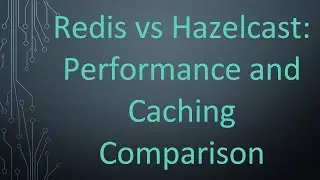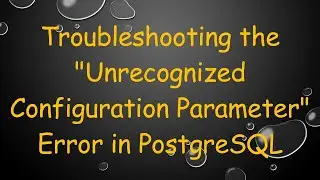Fixing ORA-00937: not a single-group group function in Oracle SQL
Discover how to resolve the `ORA-00937` error in Oracle SQL by understanding the importance of the GROUP BY clause. Learn step-by-step corrections to your SQL query.
---
This video is based on the question https://stackoverflow.com/q/73828487/ asked by the user 'user19427142' ( https://stackoverflow.com/u/19427142/ ) and on the answer https://stackoverflow.com/a/73828786/ provided by the user 'Himanshu Kandpal' ( https://stackoverflow.com/u/11227919/ ) at 'Stack Overflow' website. Thanks to these great users and Stackexchange community for their contributions.
Visit these links for original content and any more details, such as alternate solutions, latest updates/developments on topic, comments, revision history etc. For example, the original title of the Question was: Not a singlenot a single-group group function ORA-00937: Oracle
Also, Content (except music) licensed under CC BY-SA https://meta.stackexchange.com/help/l...
The original Question post is licensed under the 'CC BY-SA 4.0' ( https://creativecommons.org/licenses/... ) license, and the original Answer post is licensed under the 'CC BY-SA 4.0' ( https://creativecommons.org/licenses/... ) license.
If anything seems off to you, please feel free to write me at vlogize [AT] gmail [DOT] com.
---
Resolving the ORA-00937: Not a Single-Group Group Function Error in Oracle SQL
When working with Oracle SQL, encountering errors can be a frustrating experience. One such common error is the ORA-00937: not a single-group group function. This error typically appears when SQL queries are improperly constructed, particularly in relation to using aggregate functions. Understanding how to troubleshoot and fix this issue is crucial for creating effective SQL statements that produce the desired results.
What Causes the ORA-00937 Error?
The ORA-00937 error arises from misuse of aggregate functions like SUM, AVG, or COUNT without correctly specifying how the rows should be grouped. The underlying problem is often associated with the GROUP BY clause, which is essential in indicating how different rows will be aggregated based on specified criteria—a vital step in obtaining meaningful aggregate data.
Key Points:
Aggregate functions require a GROUP BY clause to function properly when returning non-aggregated columns.
If an aggregate function is called without a corresponding GROUP BY, Oracle does not know how to group the data, leading to this error.
Steps to Fix the Error
Let’s dissect a SQL query that's causing the ORA-00937 error and see how to repair it effectively.
Example Query with the Error:
[[See Video to Reveal this Text or Code Snippet]]
Analyzing and Correcting the Query:
Identify Where to Add the GROUP BY Clause:
The error indicates that there’s a need for a GROUP BY for the outer query. This means we need to specify how the selected columns should be aggregated.
Modify the Query:
Here's the corrected SQL statement with the proper grouping applied at both levels.
[[See Video to Reveal this Text or Code Snippet]]
Changes Made:
Added GROUP BY Clause: Both the inner and outer queries now have the GROUP BY clause, ensuring that all non-aggregated columns are accounted for during the aggregation process.
Conclusion
Addressing the ORA-00937: not a single-group group function error requires a thorough understanding of how GROUP BY works in SQL. By ensuring that any SQL statement using aggregate functions is properly grouped, you can eliminate this error and obtain accurate results from your queries. Embrace the power of proper SQL structuring and eliminate frustrating roadblocks in your database management tasks!

![Vakabular Sample Pack Vol. 1 Demo [Tech & Prog]](https://images.mixrolikus.cc/video/pHfyFVMnAnI)





























